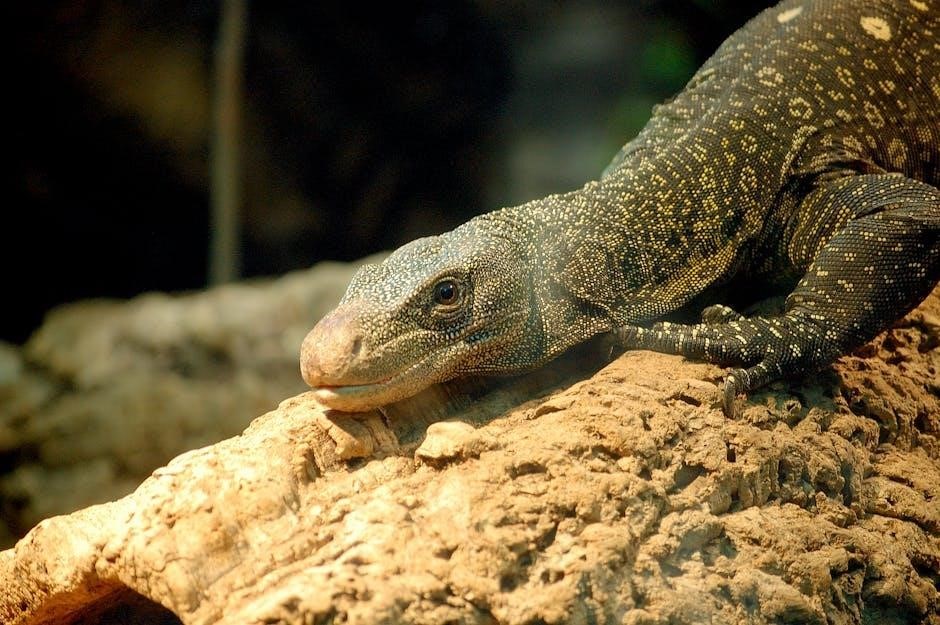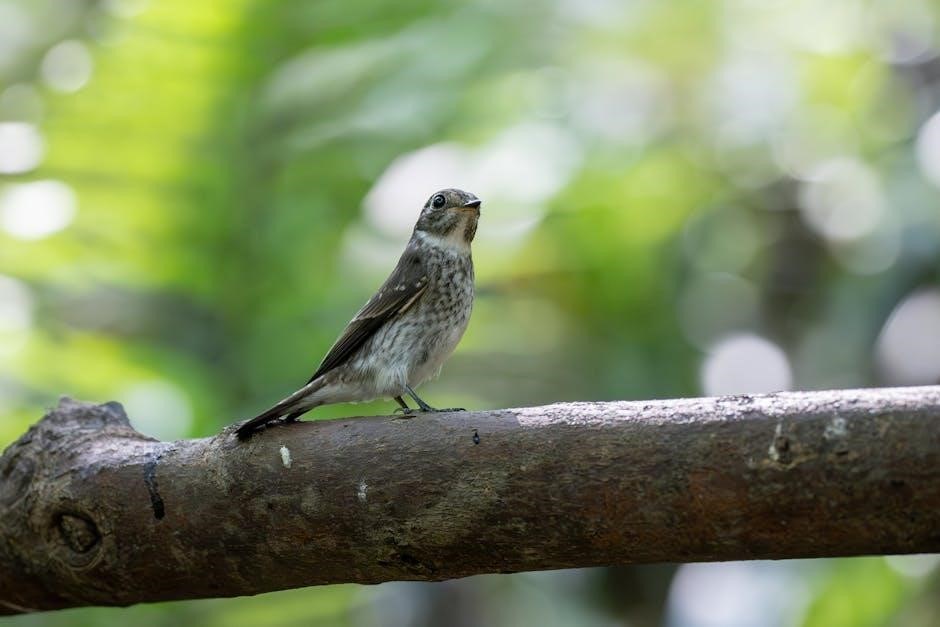Ecology is the study of interactions between organisms and their environment, focusing on biotic and abiotic factors. It helps understand how life adapts, evolves, and thrives in ecosystems. By exploring ecological principles, we address environmental challenges and promote biodiversity conservation effectively.
What is Ecology?
Ecology is the scientific study of how organisms interact with each other and their environment. It examines both biotic (living) and abiotic (non-living) factors within ecosystems. Ecology helps us understand how life adapts, evolves, and thrives in various environments. By studying ecology, we gain insights into the complex relationships between species, habitats, and environmental conditions. This field of study is essential for addressing environmental challenges, conserving biodiversity, and managing natural resources sustainably. Ecology applies to all levels of life, from individual organisms to entire biospheres, and is crucial for understanding the interconnectedness of life on Earth. It provides a foundation for developing strategies to protect ecosystems and promote ecological balance in the face of human impact and climate change.
Importance of Studying Ecology
Studying ecology is crucial for understanding the intricate relationships within ecosystems and addressing environmental challenges. It provides insights into how human activities impact biodiversity and natural resources, enabling sustainable practices. Ecology helps formulate conservation strategies, manage wildlife, and mitigate climate change effects. By understanding ecological principles, we can develop solutions to global issues like deforestation, pollution, and species extinction. Ecology also informs policies that promote environmental health and economic stability. Ultimately, it equips us with the knowledge to protect ecosystems, ensuring a balanced and thriving planet for future generations. The study of ecology is vital for maintaining ecological balance and preserving life’s diversity on Earth.
Biotic and Abiotic Factors
Biotic factors are living components in an ecosystem, such as plants, animals, and microbes. Abiotic factors are non-living elements like sunlight, water, and temperature. Together, they shape ecosystems.
Definition of Biotic Factors
Biotic factors refer to all living components within an ecosystem. These include producers, such as plants and algae, which create their own food through photosynthesis. Consumers, like animals, insects, and fungi, obtain energy by consuming other organisms. Decomposers, such as bacteria and fungi, break down dead organic matter, recycling nutrients back into the environment. Additionally, biotic factors encompass the interactions between these organisms, such as predation, symbiosis, and competition. These interactions play a crucial role in maintaining the balance and diversity of ecosystems. Understanding biotic factors is essential for studying how life forms depend on each other and their environment.
Definition of Abiotic Factors
Abiotic factors are non-living components of an ecosystem that influence the survival and interactions of organisms. These include physical and chemical elements such as light, temperature, water, soil, air, and minerals. Climatic conditions like rainfall, humidity, and wind also fall under abiotic factors. Additionally, factors like pH levels, oxygen levels, and nutrient availability play a critical role in shaping the environment. Unlike biotic factors, abiotic elements do not depend on living organisms for their existence. They create the foundation for life, determining the types of plants and animals that can thrive in a particular environment. Understanding abiotic factors is vital for analyzing how ecosystems function and how they respond to changes in environmental conditions.
Examples of Biotic and Abiotic Factors
Biotic factors include living organisms such as plants, animals, fungi, and bacteria. For example, grass, birds, and decomposing fungi are biotic factors in a forest ecosystem. Abiotic factors, on the other hand, are non-living components like sunlight, temperature, water, and soil. In a desert ecosystem, examples of abiotic factors include sand, wind, and minerals. Both types of factors interact to create a balanced environment. For instance, sunlight (abiotic) supports plant growth (biotic), which in turn provides habitat for animals (biotic). Understanding these examples helps in analyzing how ecosystems function and how changes in one factor can impact others. These interactions are essential for maintaining ecological harmony and biodiversity.

Levels of Ecological Organization
Ecological organization ranges from individual organisms to ecosystems, biospheres, and biomes, each level building on the previous to understand life’s complex interactions and structures in nature.
Overview of the Six Levels
The six levels of ecological organization are structured to understand the complexity of life and its interactions. Starting from the simplest, the levels are: organism, population, community, ecosystem, biome, and biosphere. An organism is an individual living being, while a population consists of all individuals of the same species in a specific area. A community includes all populations of different species interacting within a region. An ecosystem adds abiotic factors to the community, shaping the environment. A biome represents a large, geographically distinct ecosystem type, like forests or deserts. Finally, the biosphere encompasses all life on Earth, integrating all biomes into a global system. These levels provide a framework for studying ecological relationships and processes systematically.
Key Differences Between Each Level
The six levels of ecological organization are distinct in scope and complexity. An organism focuses on a single individual, while a population includes all individuals of the same species in a specific area. A community expands to include all species within a region, highlighting interactions between different organisms. An ecosystem adds abiotic factors, showing how living and non-living components interact. A biome represents a broader regional ecosystem type, like a desert or forest, sharing similar characteristics. Finally, the biosphere encompasses all life on Earth, integrating all biomes globally. Each level builds on the previous one, providing a hierarchical framework to study ecological systems and their intricate relationships.

Ecosystems and Energy Flow
An ecosystem includes both biotic and abiotic factors, interacting to form a functional unit. Energy flows through ecosystems via food chains, starting with producers and moving to consumers.
What is an Ecosystem?
An ecosystem is a functional unit that includes all living organisms (biotic factors) and non-living components (abiotic factors) in a specific environment. It encompasses interactions between plants, animals, microbes, soil, water, air, and sunlight within a defined area. Ecosystems can vary in size, from a small pond to a vast desert. They are characterized by energy flow and nutrient cycling, which sustain life and maintain balance. Healthy ecosystems provide essential services like clean air, water purification, and food production. Understanding ecosystems is crucial for addressing environmental challenges and promoting conservation efforts. Studying ecosystems helps us appreciate how biotic and abiotic factors depend on each other for survival and stability.

Energy Flow in Ecosystems
Energy flow in ecosystems is the unidirectional transfer of energy from one organism to another, beginning with producers and moving through consumers. Producers, such as plants, capture sunlight via photosynthesis, forming the base of the energy pyramid; Herbivores consume producers, transferring energy to the next trophic level, while carnivores obtain energy by consuming other animals. Decomposers break down dead organisms, returning energy to the environment. Energy loss occurs at each level due to metabolic processes, explaining why food chains are short. Typically, only 10% of energy is transferred between trophic levels. This flow sustains ecosystem balance and supports life, emphasizing the critical role of producers and the efficiency of energy transfer in maintaining ecological stability and biodiversity. Understanding energy flow is essential for grasping ecosystem dynamics and conservation strategies.
The Role of Producers and Consumers
Producers, such as plants, algae, and some bacteria, are organisms that create their own food through photosynthesis, converting sunlight into energy. They form the base of the food web and are essential for sustaining life in ecosystems. Consumers, on the other hand, cannot produce their own food and rely on producers for energy. Consumers include herbivores (plant-eaters), carnivores (meat-eaters), omnivores (both plant- and meat-eaters), and decomposers (which break down dead organisms). The interaction between producers and consumers ensures energy transfer and nutrient recycling within ecosystems. Producers provide the energy required for consumers to survive, while consumers help regulate producer populations, maintaining ecological balance. This interdependence highlights the critical roles both play in sustaining ecosystem structure and function.
Food Chains and Food Webs
Food chains show a linear sequence of energy transfer, while food webs illustrate a complex network of relationships. Both demonstrate how energy flows through ecosystems, with energy decreasing at each level.
Differences Between Food Chains and Food Webs
Food chains and food webs are tools to represent energy flow in ecosystems. A food chain is a linear sequence showing how energy moves from one organism to another, while a food web is a network of interconnected food chains. Food chains are simpler and show a single pathway of energy transfer, whereas food webs demonstrate multiple pathways, reflecting the complexity of ecological interactions. Food chains are less flexible and represent a specific energy flow, while food webs provide a broader view of how energy is distributed across an ecosystem. Food chains are less stable as the loss of one species can disrupt the entire chain, whereas food webs are more resilient due to their interconnectedness. Understanding both helps in analyzing ecosystem dynamics and the flow of energy within communities.
How Energy Moves Through an Ecosystem
Energy flows through ecosystems via food chains and webs, starting with producers like plants that capture sunlight through photosynthesis. These organisms transfer energy to herbivores, which are then consumed by carnivores. At each trophic level, only a fraction of energy (about 10%) is passed on due to metabolic processes. Decomposition returns energy to the environment as heat or organic matter. This unidirectional flow ensures energy is continuously cycled, sustaining life. Producers are the primary energy source, and their efficiency in capturing sunlight determines ecosystem productivity. Understanding this flow is crucial for managing resources and maintaining ecological balance, as disruptions can cascade through the system. Efficient energy transfer is vital for the survival of all organisms within an ecosystem, emphasizing the interconnectedness of life and the environment.

Conservation Biology
Conservation biology applies ecological principles to protect biodiversity, focusing on preserving species, habitats, and ecosystems. It addresses threats like habitat loss and climate change to maintain ecological balance.
Applying Ecological Principles to Protect Biodiversity
Conservation biology uses ecological principles to protect and manage biodiversity. It focuses on understanding ecosystems, population dynamics, and species interactions to develop effective conservation strategies. Key approaches include habitat restoration, species conservation, and controlling invasive species. Ecological principles help identify critical habitats and corridors for endangered species. Additionally, conservation efforts address climate change impacts and human activities that threaten biodiversity. By applying these principles, conservationists aim to maintain healthy ecosystems and ensure the survival of diverse species. Sustainable practices, such as ecosystem management and pollution control, are essential tools in biodiversity protection. Ultimately, conservation biology seeks to preserve ecological integrity and promote coexistence between humans and nature for future generations.

